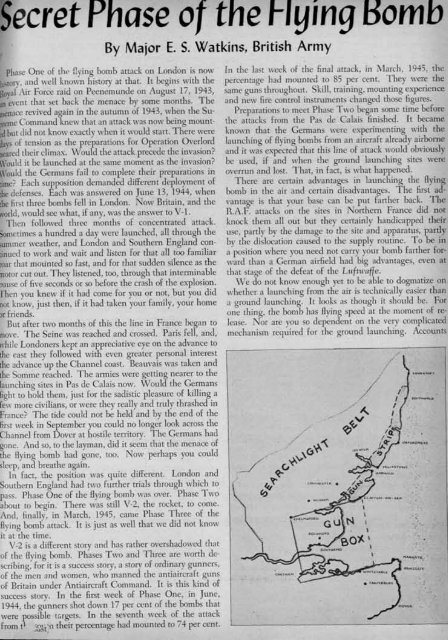September-October - Air Defense Artillery
September-October - Air Defense Artillery
September-October - Air Defense Artillery
Create successful ePaper yourself
Turn your PDF publications into a flip-book with our unique Google optimized e-Paper software.
~ecretPhase of the ""yit19 Bomb<br />
By Major E. S. Watkins, British Army<br />
Phase One of tlw Gying bomb attack on London is now<br />
istory,and well known history at that. It begins with the<br />
o\"aI<strong>Air</strong> Force raid on Peenemunde on August 17, 1943,<br />
n'event that set back the menace by some months. The<br />
enacerevived again in the autumn of 1943, when the SuremeCommand<br />
knew that an attack was now being mount-<br />
Ibut did not know exactly when it would start. There were<br />
aysof tension as the preparations for Operation Overlord<br />
earedtheir climax. vVould the attack precede the invasion?<br />
ould it be launched at the same moment as the invasion?<br />
Vould the Germans fail to complete their preparations in<br />
ime? Each supposition demanded different deployment of<br />
hedefenses. Each was answered on June 13, 1944, when<br />
hefirst three bombs fell in London. Now Britain, and the<br />
orld,would see what, if any, was the answer to V-I.<br />
Then followed three months of concentrated attack.<br />
ometimes a hundred a day were launched, all through the<br />
ummer weather, and London and Southern England coninued<br />
to work and wait and listen for that all too familiar<br />
oarthat mounted so fast, and for that sudden silence as the<br />
otorcut out. They listened, too, through that interminable<br />
auseof five seconds or so before the crash of the explosion.<br />
[hen you knew if it had come for you or not, but you did<br />
ot know, just then, if it had taken your family, your home<br />
>rfriends.<br />
But after two months of this the line in France began to<br />
ove. The Seine was reached and crossed. Paris fell, and,<br />
hile Londoners kept an appreciative eye on the advance to<br />
he east they followed with even greater personal interest<br />
he advance up the Channel coast. Beauvais was taken and<br />
he Somme reached. The armies were getting nearer to the<br />
aunching sites in Pas de Calais now. vVould the Germans<br />
ight to hold them, just for the sadistic pleasure of killing a<br />
ew more civilians, or were they really and truly thrashed in<br />
rance? The tide could not be held and by the end of the<br />
irst week in <strong>September</strong> you could no longer look across the<br />
hannel from Dover at hostile territory. The Germans had<br />
one. And so, to the layman, did it seem that the menace of<br />
he Hying bomb had gone, too. Now perhaps you could<br />
leep, and breathe again.<br />
In fact, the position was quite different. London and<br />
Southern England had two further trials through which to<br />
pass. Phase One of the Hying bomb was over. Phase Two<br />
about to begin. There was still V-2, the rocket, to come.<br />
And, finally, in March, 1945, came Phase Three of the<br />
Hying bomb attack. It is just as well that we did not know<br />
it at the time.<br />
V-2 is a different story and has rather overshadowed that<br />
of the Hying bomb. Phases Two and Three are worth describing,<br />
for it is a success story, a story of ordinary gunners,<br />
of the men and women, who manned the antiaircraft guns<br />
of Britain under Antiaircraft Command. It is this kind of<br />
success story. In the first week of Phase One, in June,<br />
1944, the gunners shot down 17 per cent of the bombs that<br />
were possible ttirgets. In the seventh week of the attack<br />
from t~ ';~si::1their percentage had mounted to 74 per cent.<br />
In the last week of the final attack, in March, 1945, the<br />
percentage had mounted to 85 per cent. They were the<br />
same guns throughout. Skill, training, mounting experience<br />
and new fire control instruments changed those figures.<br />
Preparations to meet Phase Two began some time before<br />
the attacks from the Pas de Calais finished. It became<br />
known that the Germans were experimenting with the<br />
launching of Bying bombs from an aircraft already airborne<br />
and it was expected that this line of attack would obviously<br />
be used, if and when the ground launching sites were<br />
overrun and lost. That, in fact, is what happened.<br />
There are certain advantages in launching the Hying<br />
bomb in the air and certain disadvantages. The first advantage<br />
is that your base can be put farther back. The<br />
R.A.F. attacks on the sites in Northern France did not<br />
knock them all out but they certainly handicapped their<br />
use, partly by the damage to the site and apparatus, partly<br />
by the dislocation caused to the supply routine. To be in<br />
a position where you need not carry your bomb farther forward<br />
than a German airfield had big advantages, even at<br />
that stage of the defeat of the Luftwaffe.<br />
\iVe do not know enough yet to be able to dogmatize on<br />
whether a launching from the air is technically easier than<br />
a ground launching. It looks as though it should be. For<br />
one thing, the bomb has Bying speed at the moment of release.<br />
Nor are you so dependent on the very complicated<br />
mechanism required for the ground launching. Accounts<br />
/<br />
./<br />
/' ~<br />
~v<br />
















